Building and Sailing of PDR 682
By Tom Lynch
On Saturday, July 14, 2012, I drove my newly built Simple 18 Puddle Duck Racer to a local mountain lake. A very small car towing a very small sailboat on a very small trailer – no problem. I rigged the boat with about 35 sq. feet of poly tarp sail (a beginner’s sail), using a boom and a top sprit. The mid-afternoon wind ran from 5-10 m.p.h. with occasionally higher gusts. We (myself, my girlfriend, and our 9 pound dog) launched into the wind from a sandy beach. Zero tiller experience in the boat by the way. I used the oars to clear the shoreline a bit and then began sailing.

Initial results were excellent. We glided along in the light wind, tacked a couple of times, and jibed only once (unintentionally). After a time, I began to experience unresponsiveness. I noticed the pull-up rudder was in the “up” position, confirming that wood is indeed lighter than water. Obviously, the shock-cord placed to keep it down was inadequate. While becoming preoccupied with the rudder problem, I then noticed that the leeboard had also swung from the down position to the “up” position alongside the hull. This resulted in the instantaneous and total loss of all control, which, unfortunately, seemed to coincide with a pick up in the wind. Additionally, I failed to keep track of our surroundings while repeatedly pushing the rudder back to the down position, hoping it might stay down. By the time I became aware of the leeboard problem, the wind was taking our boat backwards (that’s layperson’s talk for aft) over a floating rope demarcating the boundary of the boating area near a wall of shoreline rocks. This belated observation led me to let go of the mainsheet and grab for the oars, which I began to row, mightily.
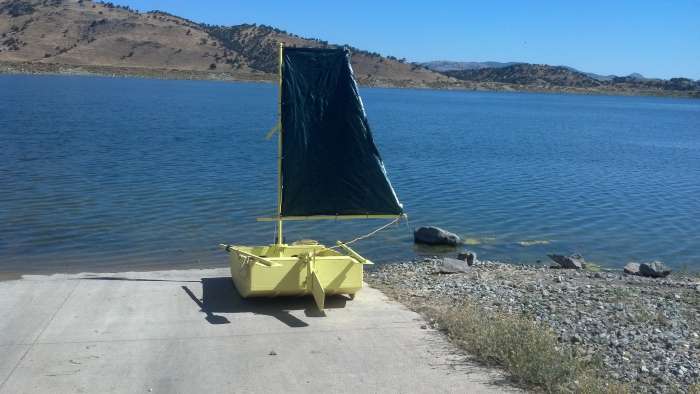
Unfortunately, my oars were made of thin aluminum tube and designed for a small inflatable. We were three beings with a loaded ice chest in a Simple 18. My girlfriends extended foot saved us from the rocks. One of the oars bent under the strain before we exited the danger area, clearing the floats and warning rope on our way out. After tangling with the warning rope, placed a loop of thicker stretch cord (I did bring some) to fix the lee board in the down position. We were on the leeward edge of the lake in light wind. I was able to sail windward for a little while but found I couldn’t correctly tack. I found myself repeatedly grabbed the boom and found myself watching the leach flutter as I swung the boom side to side trying to get out of “being in irons.” I had by this time, nonetheless, already experienced sailing to windward, and that produced a great feeling. I also jibed a second time (again unintentionally).
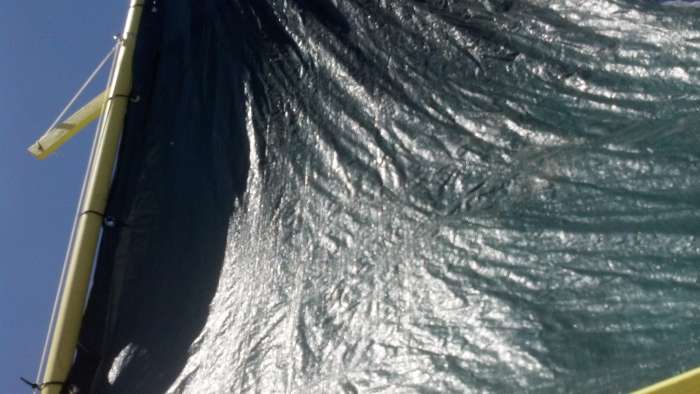
By the time we experienced an increase in wind gusts (after repeated bouts of “being in irons”) I bent the already damaged aluminum oar into a useless “L” shape. In this connection, I should mention that I bolted magnificent “hot poured” galvanized steel ore locks onto the gunnels, and they worked great. I was, however, ultimately limited to one small oar for use as a paddle. I took out my wire cutters (the only tool I kept on my person) and snipped the plastic ties to release the poly tarp sail from the boom. I released the cleat line through the “snotter” and quickly “furled” the sail, tying it and the dangling sprit to the mast with a piece of string. I then sat up over the stern bulkhead, paddled the boat towards the nearest sandy shoreline, making a successful beach landing. I recall thinking that paddling the boat was easier than rowing it. Having never actually rowed a boat with oars, I should mention I have had some experience paddling a kayak. The best news is that (based on a careful inspection) the boat’s inside remained bone dry, everywhere (including both flotation chambers). We were never uncomfortable and the boat remained very stable in the water.
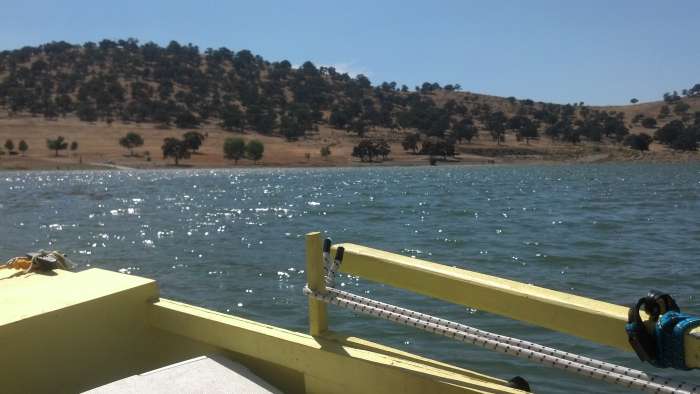
After work on Monday, July 16, I began constructing eight-foot wooden oars. I was planning my next weekend, thinking I’d row the boat to the far (windward) side of the lake, putting plenty of distance between the boat and that warning rope and rocky shoreline. I already knew the PD Racer is an amazing boat, and I was more determined than ever to learn how to sail.
Since that day in July, 2012, I have taken my PD Racer out every weekend through the present (mid-October); always on Saturday but a few times on both Saturday and Sunday. I typically sail the entire day. These mountains in Southern California are windy, although temperatures could well remain warm enough for sailing through November. My small sail continues to hold up, constructed from a 6’ X 8’ poly tarp bought for about $4.00. Because this mountain pass experiences significant wind, even this small sail provides many exciting moments.
I use an inexpensive hand-truck to move my boat from the car trailer down a cement launch ramp to the water, and back again. The (approx.) 4’ X 4’ trailer is very adequate for transport, although so tiny that no amount of skill permits it to back down a ramp. All substantial hull wear and tear has been borne by the three runners installed along the 3/8” plywood bottom (although there are scrapes and even tiny cracks in the plywood here and there).
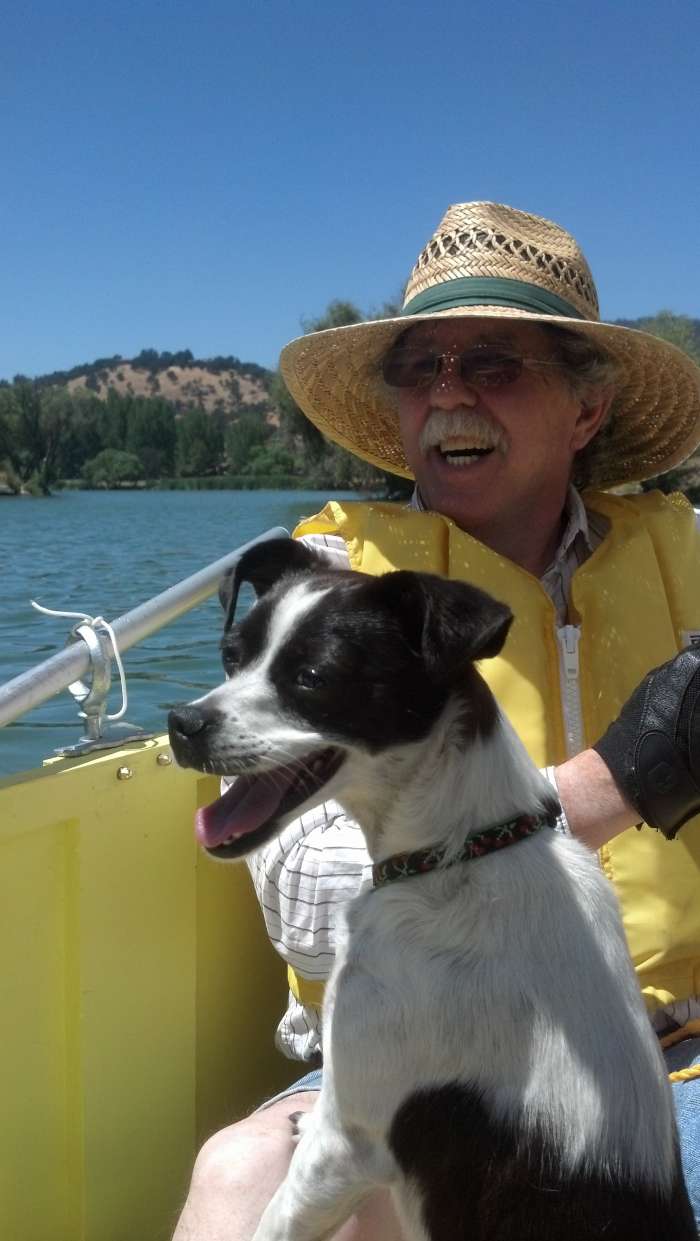
This winter I will do a bit of sanding and patch up, and likely apply a second layer of glass and epoxy to the outside seams of the hull. I also plan to construct a balanced lug sail to replace my starter-sail, complete with at least one reef line out of respect for these winds. I will keep at least one small sail as a reserve; impossible not to do at $4.00 a pop. Even here, there are times when the wind fails, and on a couple of days the wind has shifted 180 degrees. Last Saturday for example, the wind was easterly (untypical) and shifted mid-day to westerly (typical). At some point, while the east side of the lake was predominately windward, I struck the sprit, partially furled, and secured my rudder with a shock-cord to “heave to.” I then stood up in my boat and spun cast for a while in the middle of the lake. I then took advantage of the untypical easterly wind to explore what is usually the leeward side of the lake, skimming over weedy shallows with leeboard up and oars barely touching the surface. After a beach landing and brief rest in the shade of a large tree, I unfurled and skimmed down wind. To my complete satisfaction, the wind then transitioned east to west in a matter of minutes without lull or shifting gusts. I spent the last two hours that afternoon the way sailing is suppose to be; in a steady breeze with deep water and the launch ramp to windward.
The boat was built by me, essentially a novice, based on specifications and information provided by Shorty Pen on the PD racer website, as well as information from Jim Michalak found on the internet and elsewhere (including his plans and his awesome book, “Boat Building for Beginners, And Beyond”). I have included with this essay some photographs of the boat, and sailing.
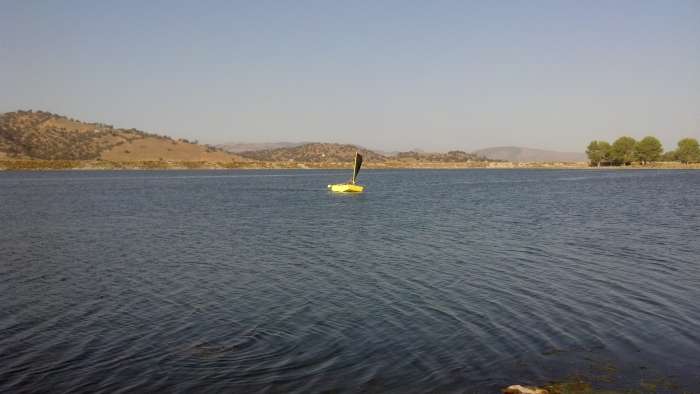
Regarding the construction, except for the decks and mast partner under-board, which are screwed down, the hull is glued together using the “toothpick dowel method” (championed by Shorty) of filling and sealing hundreds of holes created by the temporary use of drywall screws (championed by Michalak) with non-toxic wood glue. All seams within the interior of the bow and stern air boxes are beaded with PL 400. The outside seams of the hull are all glassed with epoxy. The (bone dry) interior of the air boxes is treated with two coats of Thompsons Water Seal, based on a suggestion by the Arizona boat designer, Ken Simpson. The 10’ mast is based on a design by Mitch Longtin of Iowa (PDR #538), found on Shorty’s website. I filled a 1” steel tube with expanding foam insulation and inserted the tube within a 1 ¼” inch PVC pipe, shooting PL 400 glue in between the walls as I turned and inserted the tubing. Word of caution: let the expanding insulation dry inside the tube before you encase the ends of the tube inside the PVC with PL 400. If this stuff doesn’t get air, it can’t cure and can continue to bleed a bit, which you don’t want inside your mast step. I needed to perforate one bottom end of my mast and allow a small by unacceptable amount of uncured gunk to drain. For the past 3 months during many hours of use, however, I can say this construction has provided a stiff and a completely adequate mast.
p.s. The name of the boat is “NO WORRIES” in uppercase lettering with the word “WORRIES” written upside down beneath that.
Thanks for your dedication to sailing and to the PDR class. Keep up the good work.
Best wishes,
Tom Lynch
